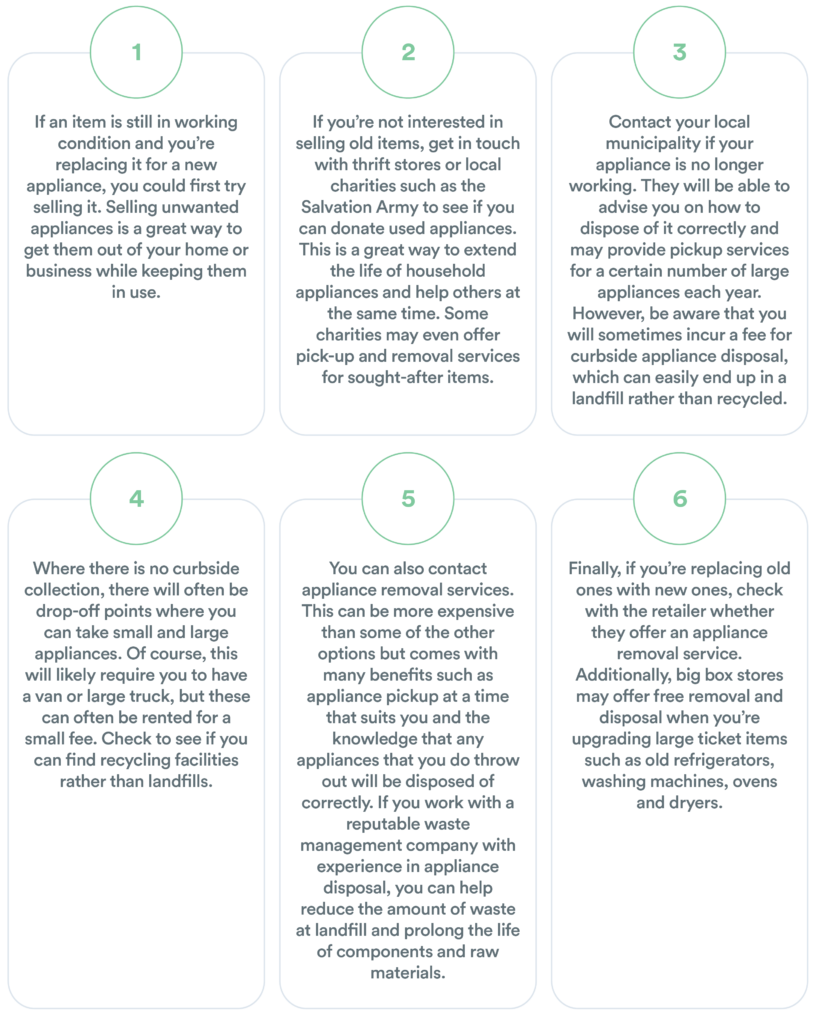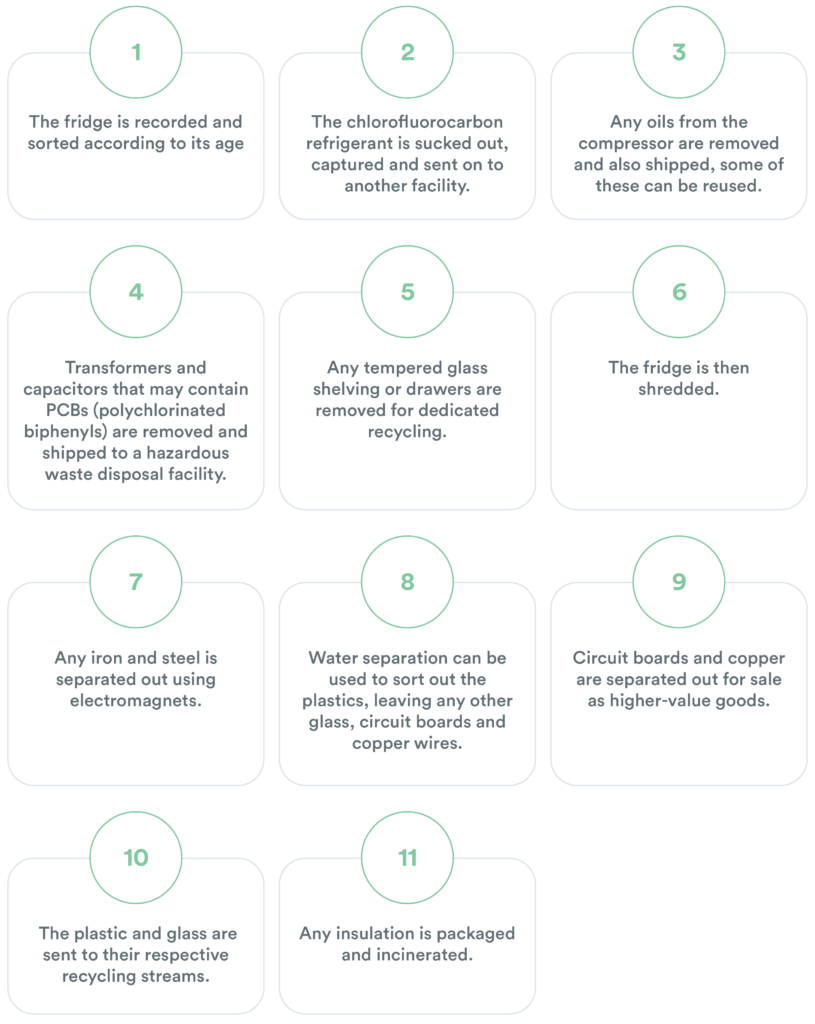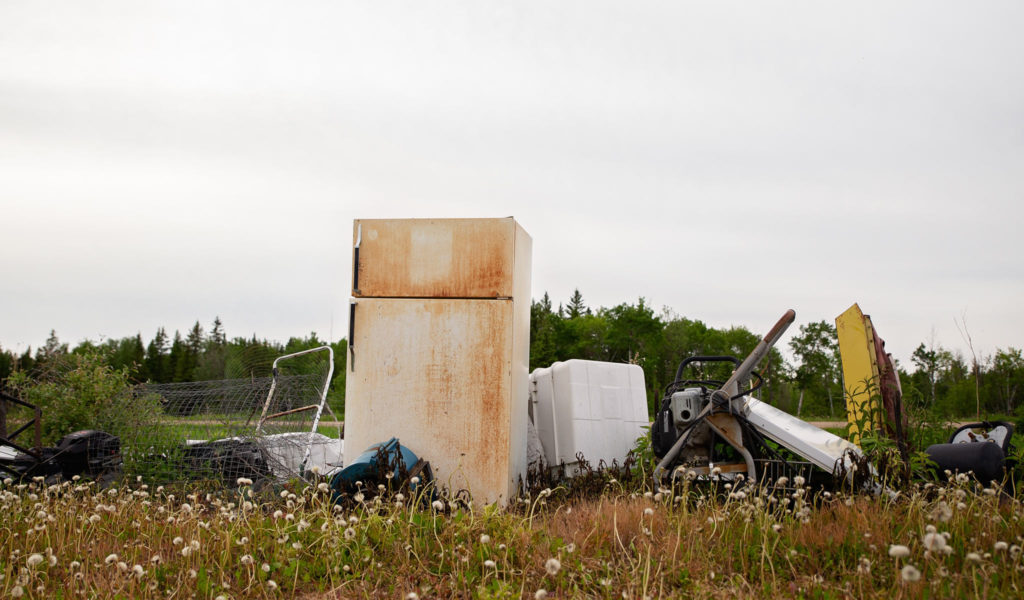It’s always stressful for homeowners when old appliances come to the end of their use: they’re expensive to replace, often vital to your day-to-day life, and whether it’s a small toaster or a large space heater, they can often feel like a literal weight around your neck!
Household appliances are difficult to dispose of for a number of reasons. First, they are too large to be any of your normal household waste streams – whether recycling or solid waste. Second, they are almost always made of a mix of materials including metals, plastic, PCBs, concrete and more; so even if they are small enough to go into your residential recycling points, they can’t be processed.
Additionally, hazardous materials within both large and small appliances can be highly polluting or toxic. Appliances such as refrigerators, freezers, air conditioners, and dehumidifiers can contain Chlorofluorocarbons (CFCs), for example, which when released into the atmosphere cause significant damage. Many other electronic appliances can contain lead, mercury, arsenic, cadmium, or other damaging elements.
However, there are several responsible appliance disposal methods, which we’ll go through now.
How to Get Rid of Old Appliances
How you dispose of used appliances depends on whether they are working or at the end of their life. Try to make a judgment call before taking any next steps since it can be considerably easier to dispose of unwanted appliances that still function. Some steps to take when looking to dispose of old appliances are:
1. If an item is still in working condition and you’re replacing it for a new appliance, you could first try selling it. Selling unwanted appliances is a great way to get them out of your home or business while keeping them in use.
2. If you’re not interested in selling old items, get in touch with thrift stores or local charities such as the Salvation Army to see if you can donate used appliances. This is a great way to extend the life of household appliances and help others at the same time. Some charities may even offer pick-up and removal services for sought-after items.
3. Contact your local municipality if your appliance is no longer working. They will be able to advise you on how to dispose of it correctly and may provide pickup services for a certain number of large appliances each year. However, be aware that you will sometimes incur a fee for curbside appliance disposal, which can easily end up in a landfill rather than recycled.
4. Where there is no curbside collection, there will often be drop-off points where you can take small and large appliances. Of course, this will likely require you to have a van or large truck, but these can often be rented for a small fee. Check to see if you can find recycling facilities rather than landfills.
5. You can also contact appliance removal services. This can be more expensive than some of the other options but comes with many benefits such as appliance pickup at a time that suits you and the knowledge that any appliances that you do throw out will be disposed of correctly. If you work with a reputable waste management company with experience in appliance disposal, you can help reduce the amount of waste at landfill and prolong the life of components and raw materials.
6. Finally, if you’re replacing old ones with new ones, check with the retailer whether they offer an appliance removal service. Additionally, big box stores may offer free removal and disposal when you’re upgrading large ticket items such as old refrigerators, washing machines, ovens and dryers.

If you’re struggling to dispose of large appliances effectively, it can be tempting to break them down into smaller, more manageable pieces – don’t! You run the risk of exposing yourself, your home or place of business, and the environment to harmful chemicals and materials.
How Are Small and Large Electronics Appliances Recycled?
If your old appliances aren’t in good enough condition to donate or sell, then you’ve come to the point that you’re getting them recycled. However, you are probably asking yourself: How does appliance recycling actually work?
First, it’s important to differentiate between electronics recycling and appliance recycling. Many of your appliances may actually be processed as e-waste, such as computers, phones, etc., so check with your local government or the EPA. Large domestic appliances, such as fridges, washing machines, etc., are often excluded from e-waste collection points and recycling drives.
The process of appliance recycling is relatively similar to other electronics and there are levels of variation between every appliance type. Generally speaking, the appliance recycling process will follow these steps:
-
- Sorting – appliances will be sorted according to criteria such as age, type and condition.
- Disassembly – appliances will be manually disassembled, removing hazardous materials and separating out reusable or valuable parts.
- Processing – appliances will be broken down (such as by shredding and crushing) to extract recyclable materials such as scrap metals, plastics and glass.
For example, if a fridge is sent off for recycling, it might go through these steps:
1. The fridge is recorded and sorted according to its age
2. The chlorofluorocarbon refrigerant is sucked out, captured and sent on to another facility.
3. Any oils from the compressor are removed and also shipped, some of these can be reused.
4. Transformers and capacitors that may contain PCBs (polychlorinated biphenyls) are removed and shipped to a hazardous waste disposal facility.
5. Any tempered glass shelving or drawers are removed for dedicated recycling.
6. The fridge is then shredded.
7. Any iron and steel is separated out using electromagnets.
8. Water separation can be used to sort out the plastics, leaving any other glass, circuit boards and copper wires.
9. Circuit boards and copper are separated out for sale as higher-value goods.
10. The plastic and glass are sent to their respective recycling streams.
11. Any insulation is packaged and incinerated.

Environmental and Health Implications of Proper Disposal of Used Appliances
Responsible appliance disposal has numerous benefits. First, it keeps waste out of landfills, where large, bulky electronics can take up a lot of space and leach harmful toxins into the soil and waterways. This has serious environmental consequences, such as the destruction of the ozone layer from improperly disposed of fridges in the second half of the 20th century. It can also have an impact on human health, such as through leached PCBs from appliance transformers and capacitors, which have been classified as a “probable human carcinogen” and confirmed carcinogen in animals.
What’s more, proper appliance disposal keeps valuable resources in use. This is first done through the reuse of appliances – whether sold or donated – and then through recycling, which reuses valuable materials. The use of recycled materials in turn saves virgin materials from being extracted, reducing the impact of appliance production on the environment and human health.
The proper disposal of old appliances, whether from home or work, is vital to building a healthier and more eco-friendly economy. Understanding how to best dispose of unwanted appliances as well as the processes behind appliance recycling can help you make the best choices the next time you have an old appliance on your hands.
To find out more about waste management and appliance recycling for your business, get in touch with our team of TRUE advisors. To learn more about responsible waste management, recycling processes, and more, subscribe to the RTS blog.



